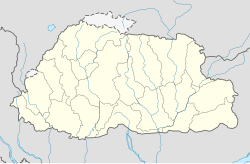| Seykhar Monastery | |
|---|---|
| Religion | |
| Affiliation | Tibetan Buddhism |
| Location | |
| Location | Bhutan |
| Country | Bhutan |
| Geographic coordinates | 27°33′33.33″N90°34′38.79″E / 27.5592583°N 90.5774417°E |
| Architecture | |
| Date established | founded by Lhodrack sey community in 1963, same guardian of Seykhar Dratsang in Tibet |
Lhodrak Seykhar Dratshang (also Sekargutho Monastery or Sey Lhakhang) is a Buddhist monastic school in Bumthang (Bhutan) near Jakar city. The name means nine story of Son. The school was established in 1963, dedicated to Marpa Lotsawa. [1]
